In-Depth Exploration of 001-gdl1ghbstssxzv3os4rfaa-3687053746
In today’s digital architecture, identifiers and hashed keys have become central to everything — from secure transactions to cloud data distribution. A key like 001-gdl1ghbstssxzv3os4rfaa-3687053746 is not just random characters; it likely serves a significant function in a system relying on precision, uniqueness, and traceability.
This article takes a forensic-style, structured look into what 001-gdl1ghbstssxzv3os4rfaa-3687053746 could represent. We do not presume it to be a placeholder or theoretical object — instead, we explore how such identifiers operate in real frameworks like object storage, session authorization, CDN referencing, and more.
Unpacking the Identifier
Dissecting the Format
The identifier 001-gdl1ghbstssxzv3os4rfaa-3687053746 can be logically split into 3 sections:
001– typically represents either a version, tier, or internal reference group.gdl1ghbstssxzv3os4rfaa– most likely a generated or encoded string, used for obfuscation, tracking, or mapping.3687053746– a 10-digit value often used for timestamps, counters, or transaction IDs.
Its structure mirrors what’s common in high-performance backend systems, but with enough character uniqueness to ensure global collision resistance.
Possible Roles of 001-gdl1ghbstssxzv3os4rfaa-3687053746
In various digital infrastructures, identifiers like this serve specialized, targeted functions. Below are five environments where 001-gdl1ghbstssxzv3os4rfaa-3687053746 could appear organically:
In Object Storage Systems
Services like Amazon S3, Google Cloud Storage, and Azure Blob rely heavily on unique keys to map user-uploaded files. Instead of a traditional filename, a cloud bucket might reference a file by:
iniCopyEditfilename = "001-gdl1ghbstssxzv3os4rfaa-3687053746"
This keeps the filename unlinked from user input — preserving security, improving lookup speeds, and preventing duplication.
In Encrypted Session Tokens
Modern authentication systems avoid direct user data references. Instead, they issue encrypted or pseudo-random session tokens, often resembling this identifier. A login API may issue:
vbnetCopyEditaccess_token: "001-gdl1ghbstssxzv3os4rfaa-3687053746"
This can be stored in browser cookies or Authorization headers to track user access securely.
As Internal CDN References
Content delivery networks cache and serve static files using unique slugs instead of direct names. This identifier could point to a specific file version or content set, used for:
- Image optimization
- Script distribution
- Multi-region cache segregation
By detaching filenames from their actual meaning, services achieve faster load times and improved security
Metadata, Tags & Digital Imprints
The importance of unique keys like 001-gdl1ghbstssxzv3os4rfaa-3687053746 becomes even more relevant when working with metadata systems. Consider the following:
- Digital Asset Management (DAM): Each image, video, or document uploaded is assigned an internal code. Users may see “ProjectImage.jpg”, but the system calls it via
001-gdl1ghbstssxzv3os4rfaa-3687053746. - API Logging Systems: When requests are tracked, each call may be tagged by an ID for audit trails.
- Content Hashing: This identifier may also represent the hash of file content, ensuring its authenticity and integrity over time.
Is It a Timestamp?
The final part, 3687053746, could plausibly represent a timestamp, but not in UNIX format. For context:
- UNIX time
3687053746maps to Sun, 03 Mar 2086 — suggesting a future-based placeholder or internal clock system offset. - Some internal systems do this to “future-proof” logs, generate predictive events, or create decoy entries.
Technical Comparisons
To understand the design logic behind 001-gdl1ghbstssxzv3os4rfaa-3687053746, let’s contrast it with other popular identifier formats:
| Identifier Type | Example | Format Comparison | Uniqueness |
|---|---|---|---|
| UUID v4 | d88a44fc-4f90-4ef2-8f38-6ec4edb3ad0d | Hyphenated, fixed length | 99.9999% |
| MongoDB ObjectID | 507f191e810c19729de860ea | Hexadecimal, 24 chars | High |
| SHA-256 | 2cf24dba5fb0a30e26e83b2ac5b9e29e... | 64 characters | Very High |
| Our String | 001-gdl1ghbstssxzv3os4rfaa-3687053746 | Custom hybrid | Likely very high |
This shows that 001-gdl1ghbstssxzv3os4rfaa-3687053746 is custom-built — likely optimized for the use-case it was created for.
Limited Exposure and Controlled Discovery
Unlike conventional filenames or public keys, this string has no discoverability. It does not reveal file type, creation source, or human-readable context. This adds:
- Privacy
- Security
- Platform-agnostic compatibility
In systems where obscurity is a form of defense, such naming conventions are critical. They are not guessable, not reversible, and not predictable.
Why It Matters for Developers and Analysts
You’re not always meant to interpret an identifier — but you must respect its structure. Engineers interacting with a key like 001-gdl1ghbstssxzv3os4rfaa-3687053746 may need to:
- Validate it before using it as a path or reference
- Secure it against injection or misuse
- Store and retrieve metadata accurately
These practices make or break systems that rely on accurate data tracking.
Real-World Integration Logic
Imagine an e-commerce platform storing all customer invoices using identifiers like this. The path might be:
arduinoCopyEdithttps://cdn.site.com/invoices/001-gdl1ghbstssxzv3os4rfaa-3687053746.pdf
Advantages:
- File names are untraceable
- Protects client data
- Supports versioning and traceability
Even if a user guesses a URL pattern, they won’t succeed without the exact ID.
Could This Be Part of a Blockchain or Token System?
Another possible source of 001-gdl1ghbstssxzv3os4rfaa-3687053746 is the blockchain world. Custom token IDs, smart contract calls, and even NFT ownership references frequently use long unique identifiers.
The lack of human-readable content and its segment-style structure lend themselves to:
- Smart contract references
- On-chain asset calls
- Off-chain bridge references
Blockchain bridges, especially those that synchronize off-chain metadata, often create secure identifiers like this to unify the data model.
Future-Proofing and Long-Term Viability
In systems planning for long-term operation — like secure archives, scientific repositories, or government records — identifiers such as this are ideal. They offer:
- Scalability into trillions of unique entries
- Language-neutral encoding
- Cross-platform interoperability
The more abstract the identifier, the more flexible it becomes over decades.
Conclusion
001-gdl1ghbstssxzv3os4rfaa-3687053746 is more than just a jumble of characters. It’s a likely outcome of thoughtful backend engineering — a symbol of precision, abstraction, and machine-first design. Whether part of an asset management system, blockchain architecture, or secure CDN, it offers a glimpse into how modern systems value uniqueness and structure over readability.
Instead of decoding it, sometimes the best approach is to respect what it protects.
visit website for more blogs: money6x.com










